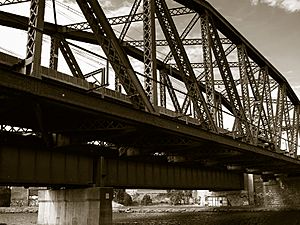Saltwater River Rail Bridge facts for kids
Quick facts for kids Saltwater River Rail Bridge |
|
|---|---|

Saltwater River rail bridge
|
|
| Coordinates | 37°47′54.00″S 144°54′59.39″E / 37.7983333°S 144.9164972°E |
| Carries | Bendigo railway line |
| Crosses | Maribyrnong River |
| Locale | Footscray, Victoria, Australia |
| Owner | VicTrack |
| Characteristics | |
| Total length | 220 ft (67 m) |
| Longest span | 220 ft (67 m) |
| Number of spans | 1 |
| Piers in water | 0 |
| History | |
| Designer | William Bryson. |
| Constructed by | girders = George Holmes & Company; bluestone abutments - Pierce & Dalziel |
| Fabrication by | William Fairbairn |
| Construction begin | 1856 |
| Construction end | 1858 |
The Saltwater River Rail Bridge is a big railway bridge in Melbourne, Victoria, Australia. It was finished in 1858 and crosses the Maribyrnong River, which used to be called the Saltwater River. This bridge was part of the railway line connecting Melbourne to Footscray. For 30 years, it had the longest single span of any bridge in Victoria.
Contents
Building the Bridge: How It Was Made
The idea to build railways from Melbourne to Bendigo and Williamstown started in 1854. A private company began the work. However, they had trouble getting enough money. Because of this, the Victorian government took over the project in 1856. They created the Victorian Railways Department to build and run the main railway lines.
Designing the Bridge
The main engineer for the railway line was George Christian Darbyshire. In November 1856, he reported that plans for the bridge over the Saltwater River were sent to England. These plans were for a bridge made of wrought iron, a strong type of iron. The stone parts of the bridge, called abutments, were made from a local stone called bluestone. These stone parts were designed by William Bryson.
Special Design from England
The bridge was designed and built by William Fairbairn & Sons in Manchester, England. It was a special type of bridge called a "tubular box girder" bridge. Here are some cool facts about its design:
- It had one main section, or "span," that was 200 feet (about 61 meters) long between its supports.
- The bridge used three large iron tubes, or "girders," each 216 feet (about 66 meters) long.
- These girders rested on two stone supports, called piers, which were 21 feet 6 inches (about 6.5 meters) above the high water level.
- The girders were placed side-by-side, about 15 feet 9 inches (about 4.8 meters) apart.
- The railway tracks sat on wooden beams, which were attached to the iron girders.
Testing the Bridge
The bridge was finished in December 1858. It was tested on January 7, 1859, just six days before the railway line officially opened. For the test, two engines pulled six wagons. These wagons were loaded with heavy iron rail chairs to make sure the bridge was strong enough.
Upgrades and New Spans
Over time, trains became heavier. In 1911, the bridge needed to be made stronger to carry these new, heavier locomotives. Temporary wooden supports were put in place first.
Replacing the Old Parts
Between 1911 and 1914, the main sections of the bridge were replaced. New parts, called "mild steel through hog-back Pratt trusses," were made by Mephan Ferguson. To keep trains running, the new parts were built inside the old ones. Once the new structure was ready, the old parts were removed. This big upgrade was finished on October 31, 1914.
Adding More Tracks
Later, more railway lines were needed.
- In 1974, a new steel bridge was built next to the original one. This new bridge had two sections and carried the tracks for the St Albans line.
- In 2012, another two-section bridge was added for the Regional Fast Rail project. This shows how important the Saltwater River crossing is for Melbourne's trains!

